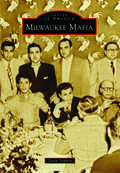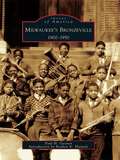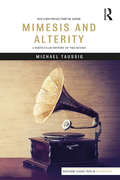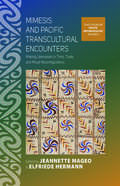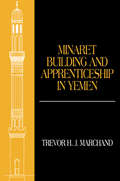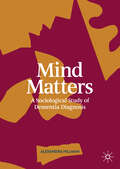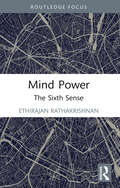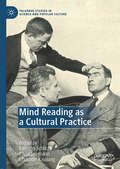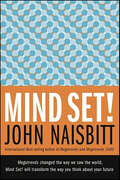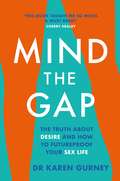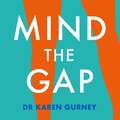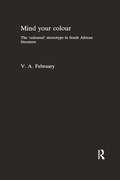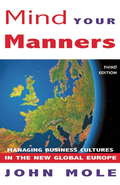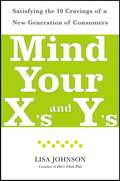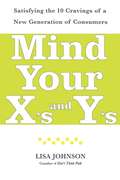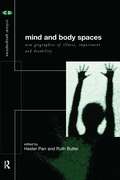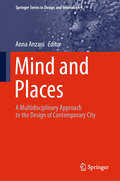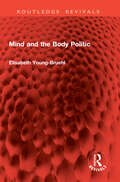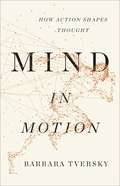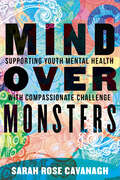- Table View
- List View
Milwaukee Mafia: Mobsters In The Heartland (Images of America)
by Gavin SchmittMilwaukee is best known for its beer--and rightfully so. But in the days of Prohibition, the big alcohol suppliers were not Miller, Blatz, Schlitz, and Pabst. The Mafia had control, and it made its money by running alcohol as far away as Canada and Indiana, as well as with counterfeiting, the numbers racket, and two of the biggest heists in American history. From then on, the sky was the limit, as the Mafia indulged in extortion, protection rackets, and skimming from Las Vegas casinos. The Cream City had its crooked lawyers, corrupt cops, and even a mayor on the take. There was the blood of those who dared to stand in the syndicate's way, who were found dead in ditches or as victims of car bombs. The members of the Mafia included doctors, real estate men, restaurateurs, tavern owners, funeral directors, union presidents, and the most famous Milwaukee gangster of all, Frank Balistrieri. While now considered extinct, the Milwaukee Family was once a dominant force in the Midwest.
Milwaukee's Bronzeville: 1900-1950 (Images of America)
by Paul H. Geenen Reuben K. HarpoleWith the migration of African American sharecroppers to northern cities in the first half of the 20th century, the African American population of Milwaukee grew from fewer than 1,000 in 1900 to nearly 22,000 by 1950. Most settled around a 12-block area along Walnut Street that came to be known as Milwaukee's Bronzeville, a thriving residential, business, and entertainment community. Barbershops, restaurants, drugstores, and funeral homes were started with a little money saved from overtime pay at factory jobs or extra domestic work taken on by the women. Exotic nightclubs, taverns, and restaurants attracted a racially mixed clientele, and daytime social clubs sponsored "matinees" that were dress-up events featuring local bands catering to neighborhood residents. Bronzeville is remembered by African American elders as a good place to grow up--times were hard, but the community was tight.
Mimesis and Alterity: A Particular History of the Senses (Routledge Classic Texts In Anthropology Ser.)
by Michael TaussigIn his most ambitious and accomplished work to date, Michael Taussig undertakes a history of mimesis, the practice of imitation, and its relation to alterity, the opposition of Self and Other. Drawing upon such diverse sources as theories of Benjamin, Adorno and Horckheimer, research on the Cuna Indians, and theories of colonialism and postcolonialism, Taussig shows that the history of mimesis is deeply tied to colonialism, and more specifically, to the colonial trade's construction of "savages." With analysis that is vigorous, unorthodox, and often breathtaking, Taussig's cross-cultural discussion of mimesis deepens our understanding of the relationship between ethnography, racism and society.
Mimesis and Alterity: A Particular History of the Senses (Routledge Classic Texts in Anthropology)
by Michael TaussigIn this ambitious and accomplished work, Taussig explores the complex and interwoven concepts of mimesis, the practice of imitation, and alterity, the opposition of Self and Other. The book moves from the nineteenth-century invention of mimetically capacious machines, such as the camera, to the fable of colonial ‘first contact’ and the alleged mimetic power of ‘primitives’. Twenty years after the original publication, Taussig revisits the work in a new preface which contextualises the impact of Mimesis and Alterity. Drawing on the ideas of Benjamin, Adorno and Horckheimer and ethnographic accounts of the Cuna, Taussig demonstrates how the history of mimesis is deeply tied to colonialism and the idea of alterity has become increasingly unstable. Vigorous and unorthodox, this cross-cultural discussion continues to deepen our understanding of the relationship between ethnography, racism and society.
Mimesis and Pacific Transcultural Encounters: Making Likenesses in Time, Trade, and Ritual Reconfigurations (ASAO Studies in Pacific Anthropology #8)
by Jeannette Mageo Elfriede HermannHow do images circulating in Pacific cultures and exchanged between them and their many visitors transform meanings for all involved? This fascinating collection explores how through mimesis, wayfarers and locales alike borrow images from one another to expand their cultural repertoire of meanings or borrow images from their own past to validate their identities.
Mimetic Theory and Islam: "The Wound Where Light Enters"
by Michael Kirwan Ahmad AchtarThis volume explores the 'Mimetic Theory' of the cultural theorist René Girard and its applicability to Islamic thought and tradition. Authors critically examine Girard's assertion about the connection between group formation, religion, and 'scapegoating' violence. These insights, Girard maintained, have their source in biblical revelation. Are there parallels in other faith traditions, especially Islam? To this end, Muslim scholars and scholars of Mimetic Theory have examined the hypothesis of an 'Abrahamic Revolution.' This is the claim that Judaism, Christianity, and Islam each share in a spiritual and ethical historical 'breakthrough:' a move away from scapegoating violence, and towards a sense of justice for the innocent victim.
Minaret Building and Apprenticeship in Yemen
by Trevor MarchandThrough a combination of rich architectural and ethnographic description, this study of apprenticeship and human spatial cognition provides a fascinating insight into the daily lives and activities of a professional class of craftsmen, and investigates the unique teaching-learning processes that distinguish their trade and mould both their professional and social characters.
Mind = Blown: Amazing Facts About This Weird, Hilarious, Insane World
by Matthew SantoroMatthew Santoro's originality and humor has attracted millions of fans, making him a beloved YouTube star. His weekly videos on amazing and little-known facts are eagerly anticipated by his many subscribers and followers around the world. In his first-ever book, Matthew's love of weird and wacky knowledge explodes with new facts and stories from around the planet, and beyond. Surprising, and always entertaining, Mind = Blown offers even more of Matthew's unique take on this hilarious, crazy world: The most ridiculous laws from past and presentCrazy doppelgangers of people, places, and unexpected thingsHistorical wizards who actually livedReal-life animal avengersAnd a special section: Japan Blows My Mind!From shin-kicking competitions and beer pong-playing robots, to enormous fire-balls shooting through space, you won't believe what you'll discover in Mind = Blown. But beware: there is too much astounding trivia for any one mind to contain!From the Trade Paperback edition.
Mind Apart
by Peter SzatmariWhy would a child refuse to talk about anything but wasp wings-or the color of subway train doors? What does it mean when a nine-year-old asks questions about death hundreds of times a day? And how can parents build a close relationship with a little girl who hates to be touched? In this compassionate book, leading autism authority Dr. Peter Szatmari shows that children with autism spectrum disorders act the way they do because they think in vastly different ways than other people. Dr. Szatmari shares the compelling stories of children he has treated who hear everyday conversation like a foreign language or experience hugs like the clamp of a vise. Understanding this unusual inner world-and appreciating the unique strengths that thinking differently can bestow-will help parents relate to their children more meaningfully, and make the "outer world" a less scary place.
Mind Matters: A Sociological Study of Dementia Diagnosis
by Alexandra HillmanAs population aging spreads to more parts of the world, dementia is fast becoming one of the most common and feared conditions of our time. Diagnosis has been identified as a key point of intervention for both biomedical and policy agendas. Drawing on ethnographic research spanning more than a decade, this book reflects on observations and recordings of UK memory clinic consultations, interview accounts with clinical staff involved in assessment and diagnosis, internationally recognised dementia researchers, and people living with dementia and their families both at the point of diagnosis and as their condition progresses. In dialogue with accounts and observations from the field, this book makes the case for the development of a sociology of dementia diagnosis. In doing so, the book progresses a dialectic approach to the study of dementia&’s construction and experience and contextualises dementia diagnosis within wider networks of meaning and systems of value related to aging, health, and personhood.
Mind Power: The Sixth Sense
by Ethirajan RathakrishnanThis book explores the mysteries of the human brain and the potential of the mind. The peculiarities and infinitude of the mind have been a theme for research for scientists and philosophers alike, for centuries. This volume presents the unanswered and highly convoluted questions and hypotheses surrounding the human mind in a simplified way. It examines the binaries of religion and science, god and nature and emotions and intelligence through a philosophical lens to posit that the relationships between cognition, belief, nature and science are what we understand and infer based on our surroundings and how much we are willing to think, learn and introspect.This book will be of interest to students of philosophy, psychology, science, popular science, psychoanalysis, cognitive studies and mental health. It will also appeal to general readers.
Mind Reading as a Cultural Practice (Palgrave Studies in Science and Popular Culture)
by Laurens Schlicht Carla Seemann Christian KassungThis book provides a genealogical perspective on various forms of mind reading in different settings. We understand mind reading in a broad sense as the twentieth-century attempt to generate knowledge of what people held in their minds – with a focus on scientifically-based governmental practices. This volume considers the techniques of mind reading within a wider perspective of discussions about technological innovation within neuroscience, the juridical system, “occult” practices and discourses within the wider field of parapsychology and magical beliefs. The authors address the practice of, and discourses on, mind reading as they form part of the consolidation of modern governmental techniques. The collected contributions explore the question of how these techniques have been epistemically formed, institutionalized, practiced, discussed, and how they have been used to shape forms of subjectivities – collectively through human consciousness or individually through the criminal, deviant, or spiritual subject. The first part of this book focuses on the technologies and media of mind reading, while the second part addresses practices of mind reading as they have been used within the juridical sphere. The volume is of interest to a broad scholarly readership dealing with topics in interdisciplinary fields such as the history of science, history of knowledge, cultural studies, and techniques of subjectivization.
Mind Set!: Eleven Ways to Change the Way You See—and Create—the Future
by John NaisbittIn his seminal works Megatrends and Megatrends 2000, John Naisbitt proved himself one of the most far-sighted and accurate observers of our fast-changing world. Mind Set! goes beyond that by disclosing the secret of forecasting. Naisbitt gives away the keys to the kingdom, opening the door to the insights that let him understand today's world and see the opportunities of tomorrow. He selects his most effective tools, 11 Mindsets, and applies them by guiding the reader through the five forces that will dominate the next decades of the twenty-first century. Illustrated by stories about Galileo and Einstein to today's icons and rebels in business, science, and sports, Mind Set! opens your eyes to see beyond media headlines, political slogans, and personal opinions to select and judge what will form the pictures of the future.
Mind The Gap: The truth about desire and how to futureproof your sex life
by Dr Karen Gurney'This book taught me so much about female desire. A must read!' Cherry HealeyDid you know that there is an orgasm gap of around 30% between heterosexual couples when they have sex? In Mind The Gap, Dr Karen Gurney, a clinical psychologist and certified psychosexologist, explores not just this gap, but the gaps in our knowledge of so much of the most important new science around sex and desire. In this book, you will learn that nearly everything that you've been led to believe about female sexuality isn't actually true. And that, despite what you might think, it is possible to simultaneously feel little to no spontaneous desire and have a happy and mutually satisfying sex life long term.Exploring the mismatch between ideas about sex in our society and what the science tells us, Mind The Gap also explains how this disconnect lies at the root of many of our sexual problems. Combining science with case studies, practical exercises and tips, this is a book for anyone who wants to better understand the mechanics of desire and futureproof their sex life, for life.
Mind The Gap: The truth about desire and how to futureproof your sex life
by Dr Karen Gurney'This book taught me so much about female desire. A must read!' Cherry HealeyDid you know that there is an orgasm gap of around 30% between heterosexual couples when they have sex? In Mind The Gap, Dr Karen Gurney, a clinical psychologist and certified psychosexologist, explores not just this gap, but the gaps in our knowledge of so much of the most important new science around sex and desire. In this book, you will learn that nearly everything that you've been led to believe about female sexuality isn't actually true. And that, despite what you might think, it is possible to simultaneously feel little to no spontaneous desire and have a happy and mutually satisfying sex life long term.Exploring the mismatch between ideas about sex in our society and what the science tells us, Mind The Gap also explains how this disconnect lies at the root of many of our sexual problems. Combining science with case studies, practical exercises and tips, this is a book for anyone who wants to better understand the mechanics of desire and futureproof their sex life, for life.
Mind The Gap: The truth about desire and how to futureproof your sex life
by Dr Karen GurneyDid you know that there is an orgasm gap of around 30% between heterosexual couples when they have sex? In Mind The Gap, Dr Karen Gurney, a clinical psychologist and certified psychosexologist, explores not just this gap, but the gaps in our knowledge of so much of the most important new science around sex and desire. In this audiobook, you will learn that nearly everything that you've been led to believe about female sexuality isn't actually true. And that, despite what you might think, it is possible to simultaneously feel little to no spontaneous desire and have a happy and mutually satisfying sex life long term.Exploring the mismatch between ideas about sex in our society and what the science tells us, Mind The Gap also explains how this disconnect lies at the root of many of our sexual problems. Combining science with case studies, practical exercises and tips, this is an audiobook for anyone who wants to better understand the mechanics of desire and futureproof their sex life, for life.(P)2020 Headline Publishing Group Ltd
Mind Your Colour
by V. A. FebruaryThis book is essentially about stereotypes as found in the literature and culture of South Africa. It deals specifically with those people referred to in the South African racial legislation as ‘coloureds’. The book is also an illustration of the way in which stereotypes function as a means of social control and repression. First published in 1981. Routledge is an imprint of Taylor & Francis, an informa company.
Mind Your Manners
by John MoleUnderstanding the nature of cultural diversity is one thing-managing it day-to-day is quite another! When doing business internationally, culture shock-and sometimes culture clash-is unavoidable. John Mole's Mind Your Manners: Managing Business Cultures in the New Global Europe is a comprehensive guide that explores cultural aspects of dozens of individual European countries as they relate to global business. Now in a fully expanded and updated third edition, Mind Your Manners includes every countriy-from the Baltics to the Balkans-applying for membership to the European Union, the world's biggest global market, and many others.Based on interviews, surveys, and workshops with over a thousand managers (of fifty nationalities), Mind Your Manners describes Europe's extraordinary political, economic, and social changes and their effects on the way we work together. New chapters on diversity, change, body language, and negotiation identify the key elements that shape the business and cultural environment of the continent, and Euroquizzes will test your knowledge and demonstrate the broad cultural spectrum of European nations. More than a mere catalog, Mind Your Manners is a must-read for anyone who intends to succeed in the European Union.
Mind Your X's and Y's
by Lisa Johnson Cheri HansonToday's 18-to-40-year-olds make for a notoriously elusive group of consumers: they're savvy, sophisticated, and particular. They're all but immune to traditional advertising and have an instinctive sense of quality and fair pricing. Inundated with choices, they are drawn to brands that satisfy not just what they need, but what they crave. At the same time, these consumers are spending money like it's going out of style. Generation X has firmly refuted its slacker reputation and is nearing the height of its earning potential. Generation Y has more buying power than any previous generation of teens and twentysomethings. But how to win their attention and loyalty? In "Mind Your X's and Y's", Lisa Johnson proves that the buying habits of 18-to-40-year-olds can be anticipated. Johnson, coauthor of "Don't Think Pink" and a leading marketing consultant, pinpoints the new rules of engagement for this Connected Generation. Based on her own and others' groundbreaking research, she looks into the heart of the Gen X and Y psyche to identify its ten core cravings -- for adventure, for high-concept design, for new families and social networks, and for personal storytelling, to name a few. This revolutionary book is packed with fascinating case studies of established and breakaway brands from every major industry, interviews with dozens of maverick thinkers and hundreds of consumers, and numerous revealing statistics. Johnson analyzes the scope of each craving to determine how it drives specific buying behaviors and offers relevant data that illustrate its impact. Mind Your X's and Y's equips anyone who wants to reach these consumers -- brand managers and their advertising, online, creative, packaging, events, and promotions teams; small-business owners and their marketing staff; advertising agencies and specialists -- with the know-how to transform market research into profitable strategies. Members of Generations X and Y are the most coveted and hard-to-reach consumers in the marketplace. Mind Your X's and Y's is a master class in how to create compelling brands for this Connected Generation.
Mind Your X's and Y's
by Lisa JohnsonToday's 18-to-40-year-olds make for a notoriously elusive group of consumers: they're savvy, sophisticated, and particular. They're all but immune to traditional advertising and have an instinctive sense of quality and fair pricing. Inundated with choices, they are drawn to brands that satisfy not just what they need, but what they crave. At the same time, these consumers are spending money like it's going out of style. Generation X has firmly refuted its slacker reputation and is nearing the height of its earning potential. Generation Y has more buying power than any previous generation of teens and twentysomethings. But how to win their attention and loyalty? In Mind Your X's and Y's, Lisa Johnson proves that the buying habits of 18-to-40-year-olds can be anticipated. Johnson, coauthor of Don't Think Pink and a leading marketing consultant, pinpoints the new rules of engagement for this Connected Generation. Based on her own and others' groundbreaking research, she looks into the heart of the Gen X and Y psyche to identify its ten core cravings -- for adventure, for high-concept design, for new families and social networks, and for personal storytelling, to name a few. This revolutionary book is packed with fascinating case studies of established and breakaway brands from every major industry, interviews with dozens of maverick thinkers and hundreds of consumers, and numerous revealing statistics. Johnson analyzes the scope of each craving to determine how it drives specific buying behaviors and offers relevant data that illustrate its impact. Mind Your X's and Y's equips anyone who wants to reach these consumers -- brand managers and their advertising, online, creative, packaging, events, and promotions teams; small-business owners and their marketing staff; advertising agencies and specialists -- with the know-how to transform market research into profitable strategies. Members of Generations X and Y are the most coveted and hard-to-reach consumers in the marketplace. Mind Your X's and Y's is a master class in how to create compelling brands for this Connected Generation.
Mind and Body Spaces: Geographies of Illness, Impairment and Disability (Critical Geographies #Vol. 1)
by Hester Parr Ruth ButlerMind and Body Spaces highlights new international research from Britain, USA, Canada and Australia, on bodily impairment, mental health and disabled peoples social worlds. The contributors discuss a variety of current issues including:* historical conceptions of the body and behaviour* contemporary political activism* matters of identity and employment* accessible housing* parenthood and child carers* psychiatric medication use* masculinity and sexuality* autobiography* social exclusion and inclusion. The contributors are: Hester Parr, Ruth Butler, Rob Imrie, Michael L. Dorn, Deborah Carter Park, John Radford, Brendan Gleeson, Isabel Dyck, Edward Hall, Pamela Moss, Gill Valentine, Christine Milligan, Flora Gathorne-Hardy, Jane Stables, Fiona Smith and Vera Chouinard.
Mind and Places: A Multidisciplinary Approach to the Design of Contemporary City (Springer Series in Design and Innovation #4)
by Anna AnzaniThis book explores the contributions of psychological, neuroscientific and philosophical perspectives to the design of contemporary cities. Pursuing an innovative and multidisciplinary approach, it addresses the need to re-launch knowledge and creativity as major cultural and institutional bases of human communities. Dwelling is a form of knowledge and re-invention of reality that involves both the tangible dimension of physical places and their mental representation. Findings in the neuroscientific field are increasingly opening stimulating perspectives on the design of spaces, and highlight how our ability to understand other people is strongly related to our corporeity. The first part of the book focuses on the contributions of various disciplines that deal with the spatial dimension, and explores the dovetailing roles that science and art can play from a multidisciplinary perspective. In turn, the second part formulates proposals on how to promote greater integration between the aesthetic and cultural dimension in spatial design. Given its scope, the book will benefit all scholars, academics and practitioners who are involved in the process of planning, designing and building places, and will foster an international exchange of research, case studies, and theoretical reflections to confront the challenges of designing conscious places and enable the development of communities.
Mind and the Body Politic (Routledge Revivals)
by Elisabeth Young-BruehlFirst published in 1989, Mind and the Body Politic is a collection of Elisabeth Young-Bruehl’s twelve essays and lectures on political theory, psychoanalysis, feminism, and the theory of biography. It is a must read for students and researchers of political philosophy, psychology, and sociology.
Mind in Motion: How Action Shapes Thought
by Barbara TverskyAn eminent psychologist offers a major new theory of human cognition: movement, not language, is the foundation of thoughtWhen we try to think about how we think, we can't help but think of words. Indeed, some have called language the stuff of thought. But pictures are remembered far better than words, and describing faces, scenes, and events defies words. Anytime you take a shortcut or play chess or basketball or rearrange your furniture in your mind, you've done something remarkable: abstract thinking without words. In Mind in Motion, psychologist Barbara Tversky shows that spatial cognition isn't just a peripheral aspect of thought, but its very foundation, enabling us to draw meaning from our bodies and their actions in the world. Our actions in real space get turned into mental actions on thought, often spouting spontaneously from our bodies as gestures. Spatial thinking underlies creating and using maps, assembling furniture, devising football strategies, designing airports, understanding the flow of people, traffic, water, and ideas. Spatial thinking even underlies the structure and meaning of language: why we say we push ideas forward or tear them apart, why we're feeling up or have grown far apart. Like Thinking, Fast and Slow before it, Mind in Motion gives us a new way to think about how--and where--thinking takes place.
Mind over Monsters: Supporting Youth Mental Health with Compassionate Challenge
by Sarah Rose CavanaghAn investigation into the mental health crisis affecting young adults today, and an impassioned argument for creating learning environments characterized both by compassion and challenge.Alarming statistics in recent years indicate that mental health problems like depression and anxiety have been skyrocketing among youth. To identify solutions, psychologist and professor Sarah Rose Cavanagh interviews a roster of experts across the country who are dedicating their lives to working with young people to help them actualize their goals, and highlights voices of college students from a range of diverse backgrounds.Cavanagh also brings the reader on an invigorating tour of pedagogical, neuroscientific, and psychological research on mental health—one that involves her own personal journey from panic to equilibrium.The result of these combined sources of inquiry indicates that to support youth mental health, we must create what Cavanagh calls compassionate challenge— first, we need to cultivate learning and living environments characterized by compassion, and then, we need to guide our youth into practices that encourage challenge, helping them face their fears in an encouraging, safe, and even playful way.Mind over Monsters is a must-read for teachers, administrators, parents, and young people themselves.
